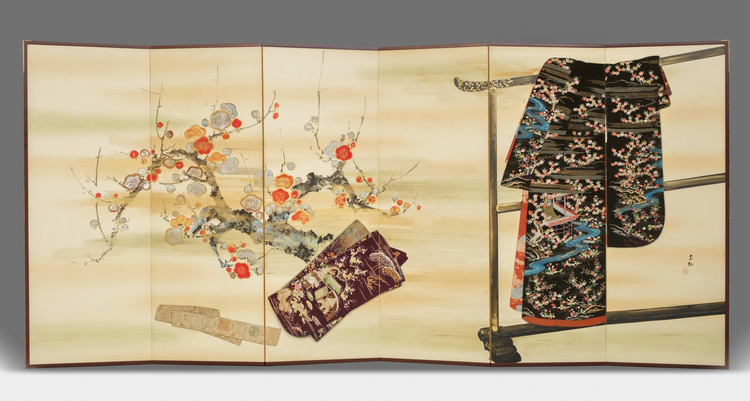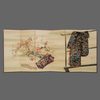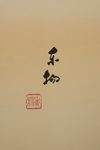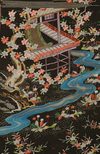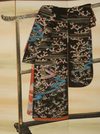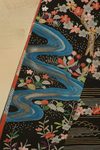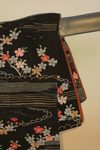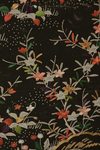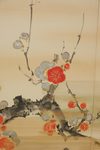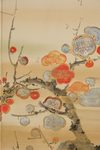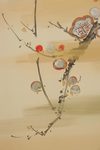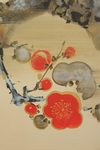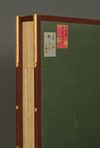Lot 166 A JAPANESE SIX PANEL BYÔBU 屏風 EMBROIDERED WITH TAGASODE 誰袖 (“WHOSE SLEEVES?”), LATE MEIJI PERIOD, EARLY TAISHO PERIOD
A beautiful, rare six-panel byôbu 屏風 (folding screen) featuring nihon shishu 日本刺繍 (Japanese embroidery) that showcases the elegant Tagasode 誰袖 (“Whose Sleeves?”) motif alongside blooming Japanese apricot blossoms 梅 (ume).
The scene depicts an ornate kimono draped over an intricate ikô 衣桁 (kimono rack) beside a flowering Japanese apricot tree. Below the kimono, two further bundles of textiles rest on the ground. Their designs feature a serene river flowing by an open pavilion, surrounded by multicoloured grass, flowers, and a temple complex.
The work is signed and sealed in the lower right corner: ‘Tôyô’ 東楊, and two inscribed labels are present at the back of the screen.
Rendered in ink, gouache, and watercolour on paper, the textiles are further enhanced by intricate hand-embroidered silk and gold thread. The screen is mounted with a burgundy lacquer frame fitted with gilt-metal hardware.
Late Meiji period to Early Taishô period (First quarter 20th century).
Total width 378.4 cm (2 x 64.6 cm and 4 x 62.3 cm), Height 172.8 cm.
In very good condition with minor wear, slight soiling, and minimal fraying of the silk threads.
In classical love poetry, the phrase Tagasode (“Whose Sleeves?”) refers to an absent woman, her beautiful robes evoking memories of their owner. Early screens featuring this motif often depict sumptuously patterned kimonos draped over lacquered clothing stands. This later example highlights fashionable textile patterns from the Edo period, including designs common in Kyoto textiles. Since the medieval period, Kyoto was renowned for its textile industry, particularly in the Nishijin district. Empress Consort Tōfukumon’in (1607–1678), wife of Emperor Go-Mizunoo (1596–1680), frequently commissioned richly ornamented garments from Kariganeya, a textile shop serving the old aristocracy. Her patronage helped establish Kyoto textiles as a symbol of imperial sophistication.
